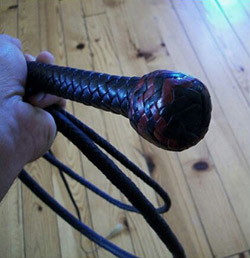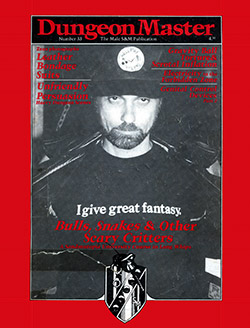By Jim the Whip Maker and Dick Carlson
Part 1: Bulls, Snakes & Other Scary Critters
Part 2: Swing & Target Practice
Part 4: The First Crack
Part 5: The First Shot – The Full Overhand Shot
Part 6: The First Useful Shot – The Pick Up
Part 7: The Real Thing – The Single Side Shot
Part 8: For the Whip Top – Dealing with Your Whip Bottom
Part 9: For the Whip Bottom – Dealing with Your Whip Top
Part 10: A Word on Cuts for Whip Bottoms
Long whips that crack come these days in three main types:
• bullwhips
• snakes or shot whips
• stock whips
 Which you use is by personal preference, if not dictated by availability.
Which you use is by personal preference, if not dictated by availability.
The bullwhip as a hard, rigid handle with an unloaded, braided thong tapering to the point. This is a good type of whip to use. A variation on the bullwhip has a handle that rotates. This is called, amazingly, a swivel-handled bullwhip. This whip is usually used for circle cracking but can be used for any shot with practice.
The snake is also called the “shot whip” as the whip is loaded usually with lead shot over about a third of its length. There is no ridged handle; the whip being flexible to the very top. This whip is good for all types of shots.
The bullwhip and snake are similar and can be thought of as American whips. The bullwhip is lighter to carry around, the snake is smaller when coiled up. They are about equivalent in effect. The bullwhip is reputed to be more accurate, although I am unconvinced, having seen experts in both.
The stock whip is different, in that it is in two parts. The handle is much like a riding crop and the braided thong, which is hinged to its end, is narrower. This is an Australian design and all Aussie whips are of this kind. It is the most accurate of them all, and very fast in action. It is harder to master and, because of the handle, requires more room to throw. It is likely therefore that you will use a bullwhip or a snake.
LONG WHIP ANATOMY
I will just note the principal parts of the whip from the top down.
The button, or butt, is the knob at the top where there may also be a loop handle. The handle grip is next and is often braided differently. This leads into the neck, where the whip part begins and where the bullwhip is first flexible. The body, or thong, is the main part, the end of which is called the point. This is where the braiding ends and is where the lash, or fall, made of rawhide or latigo strip, is attached. The cracker is the easily replaceable string at the end.
The performance of your whip is altered by the lack of a cracker, so always fit one. It takes all the wear and at a few cents a time is a good investment. Without it, the fall takes the wear and replacing falls costs money and is for the expert or professional only. Contact the store or maker for crackers if you need them.
This illustration is from Victor Tella’s Bullwhip Information Page. Victor is a highly reputable whip maker, and if you are shopping for a whip, you will find some of the best on the market in his online store.
If you have to buy a whip, a moderately-priced one will probably be fine, but avoid buying the really cheap “tourist” items that are a waste of money, however little. Try in a western supply store, if there is one nearby, or order from their catalog. Or order from a maker with a known quality of work. Be prepared to pay a good price for high grade work. Good whips are not make in ten minutes. (Here, I declare an interest as a whip maker).
The good news is that a good whip, well cared for, will last years. If you go to a maker with an exact requirement, he will make it to specification, otherwise the production model will be fine if you are just starting out.
Another tip is to not get too long a first whip. Six feet is a maximum to learn on and, remember: big whips need a lot of space. If your situation allows and you can handle it, a longer whip may be OK when you have more experience.
EDITOR’S NOTE
 Since the time of this article, Signal Whips (as seen in the illustration above) have become increasingly popular in BDSM. Snake Whips and Pocket Snake Whips are still probably the most popular BDSM whip, and they coil up nicely to wear on your belt or carry in your toy bag.
Since the time of this article, Signal Whips (as seen in the illustration above) have become increasingly popular in BDSM. Snake Whips and Pocket Snake Whips are still probably the most popular BDSM whip, and they coil up nicely to wear on your belt or carry in your toy bag.
Signal Whips do not have a fall. The cracker has traditionally been braided into the body, although most whip makers are now making Signal Whips with removable/replaceable crackers, which connect to a small loop at the end of the whip. Signal Whips can be better in confined spaces (because the fall of a Snake Whip is not counted in the length), and many who prefer them also feel that they have better accuracy without the fall.
Also very popular now are Hybrid/Target Whips, which have either a handle or a metal spike inside the body at the handle area. Many whip users feel that having a handle increases the accuracy when they are throwing.
I have bullwhips, hybrid/target whips, signal whips and snake whips. Each is like a special child and I don’t have a favourite, but I do think that whips with handles are easier to throw accurately and so have a shorter learning curve. I’m often in small indoor spaces, and a 3 foot Snake Whip or 4 foot Signal Whip is a good size for that. I also have two 2 1/2 foot signal whips, which may appear to be quite small but throw and crack beautifully. A four foot snake whip actually has a reach of nearly 6 foot, and so requires a fairly large room to enjoy.
I highly recommend working directly with a whip maker, rather than buying off-the-shelf. It probably won’t cost you any more, and you will get a whip that you love and support a grassroots craftsperson. Victor Tella (link above) is very well regarded. Two of my whips come from Mojave Outlier and they are beautiful. Check out the Whip Reviews group on Fetlife for more recommendations.
ABOUT THE AUTHOR
 This article first appeared in DungeonMaster magazine, Number 33, September 1987 published by Desmodus Publications and edited by Fledermaus (Tony DeBlase).
This article first appeared in DungeonMaster magazine, Number 33, September 1987 published by Desmodus Publications and edited by Fledermaus (Tony DeBlase).
Jim the Whip Maker and Dick Carlson taught this material as a course for the now defunct SandMutopia University, which was founded and operated by Tony DeBlase.
DungeonMaster was published from 1979 to 1992. After Tony DeBlase bought Drummer magazine in 1986, DungeonMaster became, in some ways, the little brother of its more popular stable-mate. Articles published in DungeonMaster were sometimes later reprinted in Drummer. In 1992, Desmodus Inc., which then included Drummer, Mach, Tough Customers, DungeonMaster, The Sandmutopia Guardian and The Sandmutopia Supply Company, was sold to a Dutch corporation headed by Martjin Bakker, the owner of RoB Amsterdam stores and galleries. Tony DeBlase became Editor Emeritus and passed away in 2000.


One Comment Add yours